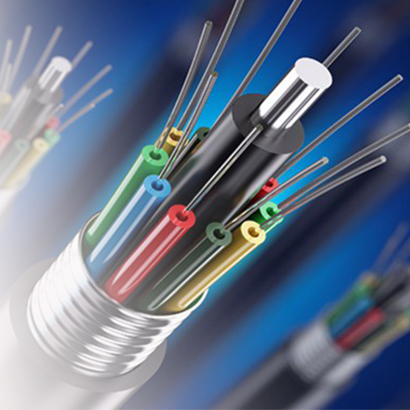Fiber Cables or Copper Cables?
When building a network that requires long distances, high speeds, and/or heavy bandwidth connections, there's no question: fiber optic cables win the day.
To understand why and where copper cables may still be the best solution, it is important to understand the differences between the two.
Cat6 Cable - BlueBoth cable types transmit data in many different ways. Copper carries electrical pulses along its strips of metal. Fiber optics, on the other hand, carry light pulses along flexible glass filaments. This difference often equates to fiber being the best solution for a new or upgraded network and therefore worth the heavier upfront investment.
5 Reasons Experts Choose Fiber Optic Cables
1. Fiber optic transmission is faster
The standard way to measure data transfer rates is bandwidth. These days, it's measured in gigabits per second (Gbps) or even terabits per second (Tbps).
Copper-based transmissions currently max out at 40 Gbps, while fiber optics can carry data at close to the speed of light. In fact, the bandwidth limits imposed on fiber are primarily theoretical, but have been tested to be measurable in hundreds of terabits per second.
2. Fiber optic transmission can cover longer distances
Both copper and fiber-based signal suffer from attenuation or attenuation of the waveform signal at long distance. However, fiber optic cables can transmit data over much longer distances. In fact, the differences are huge.
Copper cables are limited to Lengths of 100 meters (~330 ft.) by applicable standards. Longer distances are theoretically possible, but may introduce other problems that prevent copper from being a reliable method of transmission over longer distances. Fiber optic cabling can transmit well over 24 miles depending on the signaling and cable type!
3. Fiber optic cables are resistant to electromagnetic interference (EMI)
By its nature, electrical signaling in a copper network connection creates a field of interference around the wires. When you have multiple cables running close together, this interference can infiltrate nearby cables and interfere with desired messaging. This is called interference and can force expensive retransmission of the message and even pose security risks.
Light transmission in fiber optics does not generate any EMI, so the fiber becomes safer and requires less retransmission, ultimately leading to a stronger return on investment.
4. Save space and improve cable management
Fiber optic ribbons are extremely narrow. In fact, they are measured in microns or millionths of a meter. The most common fiber optic wire is the same diameter as a human hair. Yet as we've seen, they can transmit incredible amounts of data at much higher speeds over much longer distances than their less narrow copper counterparts. Fiber optic cables require a protective sheath that "lubricates" their width to at least two millimeters.
A single standard category 6 copper cable is roughly four times that width and carries some of the data. When you use fiber, it takes up much less space and is more flexible (and therefore easier to manage).
This size reduction in cabling mass has additional bonuses: the free space allows for better circulation of a data center's cooled air, makes it easier to access the equipment it's plugged into, and generally looks much more aesthetically pleasing.
5. Fiber optics are future-proof
Every year, the amount of data we consume increases, as do bandwidth requirements. Investing in a modern fiber optic cabling infrastructure will ensure your network runs at future speeds without replacing cables.
A robust multifibre backbone in a structured environment will last for years, if not decades, and will likely continue to support growing bandwidth needs. On the other hand, the average lifespan of a copper category specification is a little over five years.
Also, keep in mind that technologies and equipment that use cabling (switches, signal optics, servers, etc.) generally tend to decrease in cost as time goes on. Therefore, high-end connectivity is likely to become even more cost-effective in the future.
